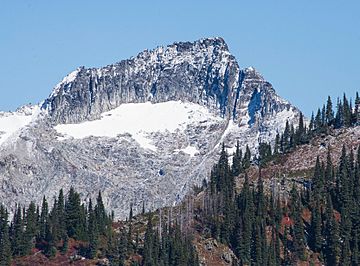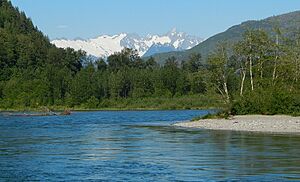Perdition Peak facts for kids
Quick facts for kids Perdition Peak |
|
|---|---|

Perdition Peak
|
|
| Highest point | |
| Elevation | 7,675 ft (2,339 m) |
| Prominence | 595 ft (181 m) |
| Geography | |
| Location | North Cascades National Park Skagit County, Washington |
| Parent range | North Cascades Cascade Range |
| Topo map | USGS Eldorado Peak |
| Geology | |
| Age of rock | Cretaceous |
| Type of rock | Orthogneiss |
| Climbing | |
| First ascent | 1967 by John Roper |
| Easiest route | Climbing YDS 4 |
Perdition Peak is a mountain in North Cascades National Park in Skagit County, Washington. It stands tall at 7,675 feet (2,339 meters). This peak is located about 1.33 miles (2.14 km) northwest of Dorado Needle and 2.12 miles (3.41 km) northwest of Eldorado Peak.
You can see Perdition Peak from the North Cascades Highway. Look for it west of Marblemount at a special viewing spot by the Skagit River. Perdition Peak is the highest point on a ridge called Backbone Ridge. Other peaks on this ridge have interesting names like In Spirit Point and The Sacrum.
The first time someone successfully climbed Perdition Peak was on August 27, 1967. A climber named John Roper made this first ascent. He was a doctor, and he often named the peaks he climbed after parts of the human body. Water from rain and melting glaciers on the mountain flows into streams that eventually join the Skagit River.
Mountain Weather
Perdition Peak is in a "marine west coast" climate zone. This means it gets a lot of influence from the Pacific Ocean. Most of the weather systems start over the Pacific and move towards the Cascade Mountains.
When these weather systems reach the North Cascades, the mountains force the air upwards. This process, called orographic lift, makes the air cool down and drop its moisture. This is why the western side of the North Cascades gets a lot of rain or snow. During winter, it's often cloudy and snowy. But in summer, high-pressure systems over the Pacific Ocean usually bring clear skies. Because of the ocean's influence, the snow here can be wet and heavy. This can sometimes lead to a high risk of avalanches.
How the Mountains Formed
The North Cascades area has very rugged land. You'll find sharp peaks, tall spires, long ridges, and deep valleys carved by glaciers. These amazing shapes and big changes in height were created by geological events that happened millions of years ago. These events also led to the different climates we see across the Cascade Range.
The Cascade Mountains started to form millions of years ago, during the late Eocene Epoch. The North American Plate was slowly moving over the Pacific Plate. This movement caused many volcanic eruptions. Also, small pieces of the Earth's crust, called terranes, joined together to form the North Cascades about 50 million years ago.
During the Pleistocene period, which was over two million years ago, glaciers repeatedly moved across the land. They carved and shaped the landscape we see today. A small piece of a glacier remains on the south side of Perdition Peak. On the northern side, you'll find larger glaciers called the Perdition and Backbone Glaciers. The river valleys in this area have a U-shape, which is a clear sign that glaciers once moved through them. The combination of land being pushed up (uplift) and cracks forming in the Earth's crust (faulting), along with the work of glaciers, created the tall peaks and deep valleys of the North Cascades.





